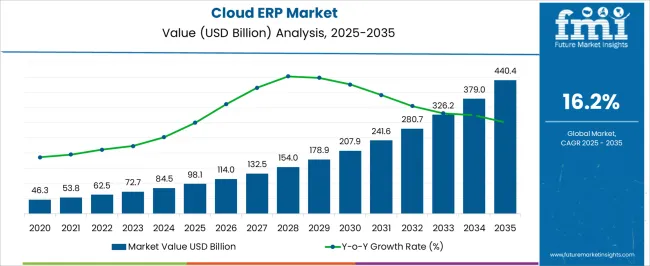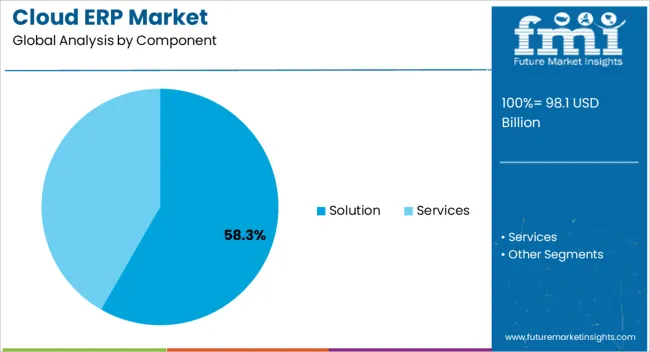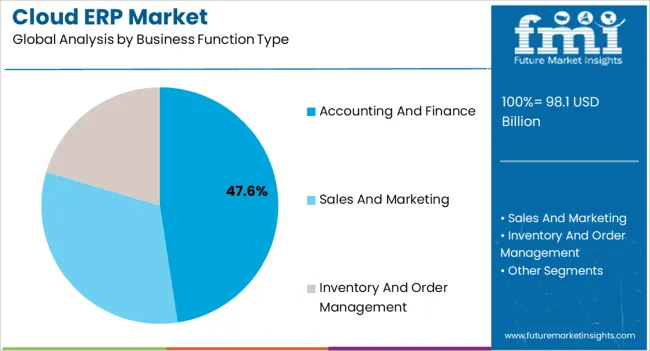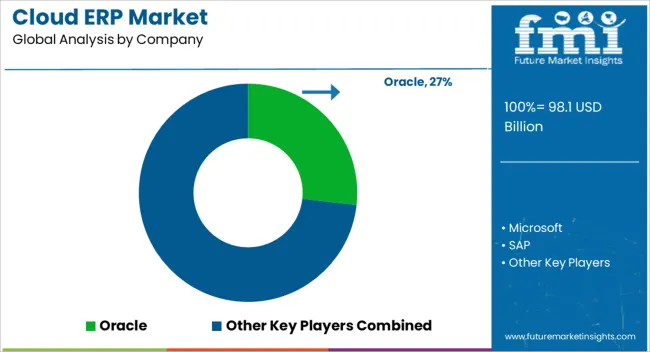The Cloud ERP Market is estimated to be valued at USD 98.1 billion in 2025 and is projected to reach USD 440.4 billion by 2035, registering a compound annual growth rate (CAGR) of 16.2% over the forecast period.

| Metric | Value |
|---|---|
| Cloud ERP Market Estimated Value in (2025 E) | USD 98.1 billion |
| Cloud ERP Market Forecast Value in (2035 F) | USD 440.4 billion |
| Forecast CAGR (2025 to 2035) | 16.2% |
The cloud ERP market is expanding rapidly as enterprises prioritize digital transformation, operational agility, and cost efficiency. The demand for scalable ERP solutions is being reinforced by the growing adoption of hybrid and multi cloud strategies across industries. Cloud ERP platforms are increasingly valued for their ability to integrate business processes, support real time analytics, and enable remote workforce collaboration.
Enterprises are also embracing cloud ERP due to reduced infrastructure costs, faster deployment cycles, and improved compliance management. Advancements in artificial intelligence and machine learning are further enhancing ERP capabilities, enabling predictive insights and automation of routine tasks.
Regulatory pressures for transparent reporting and data security are adding to the momentum of cloud based ERP adoption. The outlook remains strong as organizations shift from legacy systems toward modern ERP architectures that support innovation, global scalability, and streamlined decision making.

The solution segment is projected to account for 58.30% of the total revenue by 2025 within the component category, establishing it as the leading segment. This dominance is attributed to the growing need for centralized platforms that unify business processes and eliminate redundancies.
Cloud based ERP solutions are being increasingly adopted to optimize workflows, enhance productivity, and provide advanced analytics capabilities. The scalability and configurability of these solutions make them suitable for enterprises of different sizes and industries.
Furthermore, solution providers continue to innovate with embedded AI and advanced data visualization features, enabling real time decision making. As businesses focus on resilience and efficiency, the solution segment is expected to sustain its leadership position.

The accounting and finance segment is estimated to hold 47.60% of total revenue by 2025 within the business function type category, making it the dominant segment. Its growth is being driven by the critical importance of financial transparency, regulatory compliance, and streamlined reporting in modern enterprises.
Cloud ERP platforms enable real time financial monitoring, automate reconciliation, and support multi currency transactions, which are essential for global operations. Enhanced integration with tax, audit, and compliance modules has further supported adoption.
As organizations pursue digital finance transformation, the role of ERP in automating financial processes and improving accuracy has become indispensable, securing the leadership of this segment.
Businesses all around the world are focusing on improving their business processes to boost operational efficiency while keeping expenses under control. Businesses are looking for a centralized solution to manage a variety of business activities, including finance and accounting, sales and marketing, procurement, and supply chain management.
Cloud ERP provides businesses with the flexibility and scalability they need to improve productivity and streamline processes. Cloud ERP is one of the most important tools a company can utilize to stay ahead of the competition by assisting them in running their organization and enhancing the demand for the market. Cloud ERP ensures many things such as:
Although cloud-based solutions give businesses huge flexibility and scale, they often limit customized choices. The core product set of SaaS-based models now includes customizations. Enterprises that require substantial customization, especially concerning key functions, may find it challenging to do so with a SaaS-based ERP system.
The majority of cloud ERP vendors offer apps such as human capital management or CRM. However, just a few vendors offer a single suite of solutions that meets most of the user’s needs. These limitations are stifling cloud ERP adoption and stunting the industry's expansion.
Every business operation generates specialized data in a certain format, and businesses collect enormous amounts of data daily. Enterprises are using analytics-based solutions to draw conclusions and make data-driven decisions to handle such a fluctuating and massive stream of data, In turn, it promotes the adoption of cloud ERP.
Big data and analytics create a new income stream for cloud ERP vendors as enterprises seek analytics-based solutions. Analytics tools are used by professionals all around the world to improve asset utilization and increase operational agility and reliability.
Few firms continue to rely on their present systems due to a lack of resources, which are based on outdated technology and include manual processes. Consequently, it results in a high rate of mistakes and a long turnaround time, hampering the efficiency of the Market.
There may be several legacy programs that are incompatible with new systems or require additional integration effort. Organizations continue to oppose considerable hurdles in integrating these solutions with their existing systems due to system complexities and implementation costs.
The global cloud ERP industry size expanded at a CAGR of 14.1% from 2020 to 2025. In 2020, the global market size stood at USD 37,352.9 million. In the following years, the market witnessed tremendous growth, accounting for USD 63,420.1 million in 2025. An important factor that greatly contributes toward the growth of the market is the rising incorporation of modern technologies such as:
Several sectors, including accounting and manufacturing, are deploying AI and other advanced technology-powered solutions to automate common activities.
The market is segmented into components, organizational size, business function type, service type, application, and region. Accounting and finance are two of the most important business operations in any company. When it comes to financial data, businesses exercise extreme caution.
For worldwide enterprises in a wide range of industries, cloud ERP for finance and accounting is meant to be comprehensive, integrated, and highly scalable. It has a ledger and analytics, as well as payables and assets. It centralizes client data, recognizes revenues and invoices, generates customer invoices, receives and processes customer payments, processes customer payments, manages customer balances, and tracks bankrupt customers.
The BFSI sector is expected to see significant growth in the overall market since these solutions are primarily employed to improve the customer experience. Meanwhile, with features such as live operational tracking, secure transactions, and assessment and investigation, it is also being utilized to manage sensitive and critical data of consumers.
Large enterprises are likely to boost their demand for cloud ERP during the forecast period. Large enterprises are significantly adopting cloud-based solutions and services, and this trend is expected to continue during the forecast period. As a result, large enterprises are expected to have a prodigious CAGR of 16.5%. This is owing to the cloud ERP solution's low cost and significant economies of scale, which allow businesses to take advantage of its benefits.
Large enterprises invest heavily in manufacturing research and development, allowing them to take advantage of new digital solutions, such as cloud ERP, to optimize their business processes. In today's highly competitive world, multinational corporations, in particular, leave no stone unturned in their quest for a high market share. Hence, they invest enormous resources in becoming technologically competent.
The solution segment by component holds the lion’s share in the global market. In 2025, the solution segment garnered a 68.3% share of the global market. Based on service type, the implementation & integration segment is predicted to garner swift growth. In 2025, the implementation & integration segment captured a 43.2% share of the global market.
North America is predicted to account for the dominant market size of USD 98.1 million over the projection period due to the presence of economically and technologically advanced countries such as the United States and Canada, as well as new technologies. In 2025, North America captured 28.1% of the global market share. The United States accounted for an 18.2% share of the global market.
During the projected period, Asia-Pacific cloud-based ERP market is predicted to grow swiftly, followed by LAMEA. In Asia-Pacific, the demand for transparent and modernized manufacturing processes is projected to boost the expansion of cloud-based ERP software. India is anticipated to dominate growth in the Asia Pacific region.
The expanding telecommunication and electronics industries are expected to bolster growth in India. The surging digitalization and growing internet users are foreseen to bolster market growth in India. In 2025, India captured a 17.1% share of the global market. China is predicted to follow India, in terms of growth. In 2025, China captured a 15.4% share of the global market.
| Countries | CAGR Share in Global Market (2025) |
|---|---|
| The United States | 18.2% |
| The United Kingdom | 14.7% |
| China | 15.4% |
| Japan | 7.1% |
| India | 17.1% |

How is the Competition Intensifying in the Market?
The market is extremely competitive due to several small and large players. The cloud ERP market is highly consolidated, with top firms employing techniques such as product innovation to stay ahead of the pack. As a result, many businesses are aggressively seeking out strategic mergers and acquisitions to expand their market dominance.
The strategic framework of key service providers is focused on generating high revenues to increase profitability.
Recent Developments Observed by FMI:
| Attribute | Details |
|---|---|
| Forecast Period | 2025 to 2035 |
| Historical Data Available for | 2020 to 2025 |
| Market Analysis | USD million for Value |
| Key Regions Covered | North America; Latin America; Europe; East Asia; South Asia; Oceania; The Middle East & Africa (MEA) |
| Key Countries Covered | The United States, Canada, Germany, The United Kingdom, Nordic, Russia, BENELUX, Poland, France, Spain, Italy, Czech Republic, Hungary, Rest of EMEAI, Brazil, Peru, Argentina, Mexico, South Africa, Northern Africa, GCC Countries, China, Japan, South Korea, India, ASIAN, Thailand, Malaysia, Indonesia, Australia, New Zealand, Others |
| Key Segments Covered | Component, Business Function Type, Service Type, Organizational Size, Application, Region |
| Report Coverage | Market Forecast, Company Share Analysis, Competition Intelligence, Trend Analysis, Market Dynamics and Challenges, and Strategic Growth Initiatives |
The global cloud erp market is estimated to be valued at USD 98.1 billion in 2025.
The market size for the cloud erp market is projected to reach USD 440.4 billion by 2035.
The cloud erp market is expected to grow at a 16.2% CAGR between 2025 and 2035.
The key product types in cloud erp market are solution and services.
In terms of business function type, accounting and finance segment to command 47.6% share in the cloud erp market in 2025.






Our Research Products

The "Full Research Suite" delivers actionable market intel, deep dives on markets or technologies, so clients act faster, cut risk, and unlock growth.

The Leaderboard benchmarks and ranks top vendors, classifying them as Established Leaders, Leading Challengers, or Disruptors & Challengers.

Locates where complements amplify value and substitutes erode it, forecasting net impact by horizon

We deliver granular, decision-grade intel: market sizing, 5-year forecasts, pricing, adoption, usage, revenue, and operational KPIs—plus competitor tracking, regulation, and value chains—across 60 countries broadly.

Spot the shifts before they hit your P&L. We track inflection points, adoption curves, pricing moves, and ecosystem plays to show where demand is heading, why it is changing, and what to do next across high-growth markets and disruptive tech

Real-time reads of user behavior. We track shifting priorities, perceptions of today’s and next-gen services, and provider experience, then pace how fast tech moves from trial to adoption, blending buyer, consumer, and channel inputs with social signals (#WhySwitch, #UX).

Partner with our analyst team to build a custom report designed around your business priorities. From analysing market trends to assessing competitors or crafting bespoke datasets, we tailor insights to your needs.
Supplier Intelligence
Discovery & Profiling
Capacity & Footprint
Performance & Risk
Compliance & Governance
Commercial Readiness
Who Supplies Whom
Scorecards & Shortlists
Playbooks & Docs
Category Intelligence
Definition & Scope
Demand & Use Cases
Cost Drivers
Market Structure
Supply Chain Map
Trade & Policy
Operating Norms
Deliverables
Buyer Intelligence
Account Basics
Spend & Scope
Procurement Model
Vendor Requirements
Terms & Policies
Entry Strategy
Pain Points & Triggers
Outputs
Pricing Analysis
Benchmarks
Trends
Should-Cost
Indexation
Landed Cost
Commercial Terms
Deliverables
Brand Analysis
Positioning & Value Prop
Share & Presence
Customer Evidence
Go-to-Market
Digital & Reputation
Compliance & Trust
KPIs & Gaps
Outputs
Full Research Suite comprises of:
Market outlook & trends analysis
Interviews & case studies
Strategic recommendations
Vendor profiles & capabilities analysis
5-year forecasts
8 regions and 60+ country-level data splits
Market segment data splits
12 months of continuous data updates
DELIVERED AS:
PDF EXCEL ONLINE
Cloud ERP Industry Analysis in Latin America Forecast Outlook 2025 to 2035
Cloud Data Encryption Solutions Market Size and Share Forecast Outlook 2025 to 2035
Cloud Service Market Size and Share Forecast Outlook 2025 to 2035
Cloud Analytics Market Size and Share Forecast Outlook 2025 to 2035
Cloud Backup Service Industry Analysis in Latin America Size and Share Forecast Outlook 2025 to 2035
Cloud Compliance Market Size and Share Forecast Outlook 2025 to 2035
Cloud-Based ITSM Market Size and Share Forecast Outlook 2025 to 2035
Cloud IT Infrastructure Hardware Market Size and Share Forecast Outlook 2025 to 2035
Cloud POS Market Size and Share Forecast Outlook 2025 to 2035
Cloud Systems Management Software Market Size and Share Forecast Outlook 2025 to 2035
Cloud Telephony Services Market Size and Share Forecast Outlook 2025 to 2035
Cloud Field Service Management (FSM) Market Size and Share Forecast Outlook 2025 to 2035
Cloud Seeding System Market Size and Share Forecast Outlook 2025 to 2035
Cloud Professional Services Market Size and Share Forecast Outlook 2025 to 2035
Cloud Based Collaboration Software Market Size and Share Forecast Outlook 2025 to 2035
Cloud Printing Services Market Size and Share Forecast Outlook 2025 to 2035
Cloud Migration Service Market Size and Share Forecast Outlook 2025 to 2035
Cloudifier Market Size and Share Forecast Outlook 2025 to 2035
Cloud Database and DBaaS Market Size and Share Forecast Outlook 2025 to 2035
Cloud Computing Market Size and Share Forecast Outlook 2025 to 2035

Thank you!
You will receive an email from our Business Development Manager. Please be sure to check your SPAM/JUNK folder too.
Chat With
MaRIA